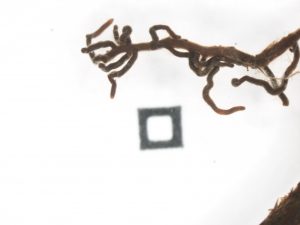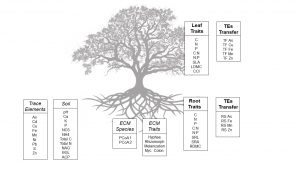Soil abiotic properties, such as texture, nutrient availability and water, are essential in the development of terrestrial plants. Mycorrhizal fungi, which are fungi living in symbiosis with plants roots, are also key for plant growing. This symbiosis enhances a trade-off of carbohydrates and nutrients beneficial for both plant and fungi. Therefore, it is expected that different mycorrhizal fungal communities (in terms of species and their morphological traits) would affect plant development (in terms of plant chemical and morphological traits) in different ways.
In order to understand this mycorrhizal fungi-plant relationship, researchers from IRNAS-CSIC and Universidad de Sevilla (Spain), in collaboration with researchers from the University of Copenhagen (Denmark) and the University of Reading (United Kingdom), developed a study on holm oak trees and their symbiotic ectomycorrhizal fungi, funded by the projects RECARE, RESTECO and INTARSU. The area selected for this study, known as the Guadiamar Green Corridor (Seville), suffered a mine spill leaving behind hectares of land contaminated by trace elements. Twenty years after the accident and the phytoremediation of the affected area, trace elements are still present and the role of ectomycorrhizal fungi might be especially important in this stressful environment.
In this study, we found that ectomycorrhizal fungi explained more than soil abiotic properties for most of the measured plant traits, especially root functional traits. The symbiosis with abundant species of ectomycorrhizal fungi (Hebeloma cavipes and Thelephora terrestris) was related to conservative positions into the root economics spectrum. Conservative traits, like denser roots and higher dry matter content, allow tree survival under adverse conditions. Hebeloma cavipes and Thelephora terrestris were characterised with a high rhizomorph formation, a fungal trait that enhances water and phosphate uptake through a long-distance exploration mechanism. It may be possible that this specific tree-fungi symbiosis was established as a consequence of resource limitations.
Trace element mobility through the soil-root-leaf continuum was analysed and despite soil trace elements concentrations in our environmental gradient was relatively large, accumulation of trace elements in oak leaves was relatively low. This confirms that holm oak is a suitable species for the phytostabilisation of contaminated soils, given its ability to prevent trace element accumulation into aboveground biomass. However, it is not the role of the tree alone, as trace element transfer was highly explained by its associated ectomycorrhizal fungal communities, which suggests that interactions with fungi play an important role at determining the capacity of this tree species to retain trace elements into its roots.
These findings support that ectomycorrhizal fungal community composition and their functional traits mediate plant performance in trace element contaminated soils, and have a high influence on plant capacity for phytoremediation of contaminants.
This study has been published in the journal Frontiers in Plant Science:


